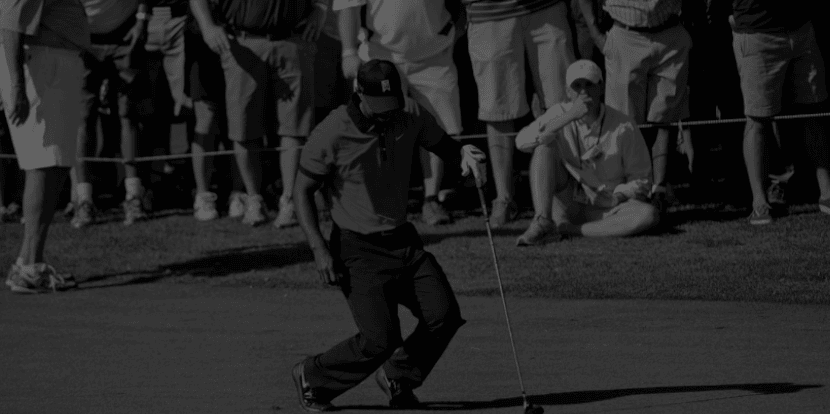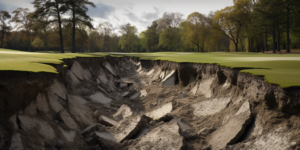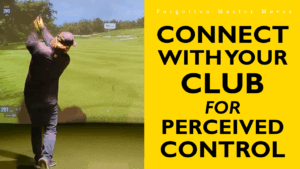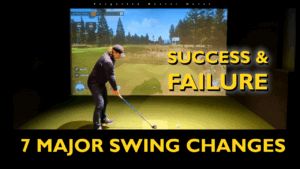
Bad Back from Golf – Lower Back Pain and Pelvic Issues
Suffering from a bad back from golf has been a major driving force behind my ten-year study of the golf swing. My back issues have kept me off the course for years, but more importantly, they’ve given me the ability to truly feel whether a technique helps or harms the body.
The reality is that most golf-related back problems likely stem from similar causes.
This article will explore the characteristics of these issues, how to manage them in everyday life, and, finally, the impact of golf technique on back health. I sincerely hope this helps someone out there.
That said, I’m not a physical therapist, and nothing I write is “science-based.” Instead, this is entirely drawn from my own journey back to this beautiful game. You read and implement at your own risk.
Bad Back from Golf – General Problem Discussion
The Problem from a Physics Perspective
Ultimately, it all comes down to the compression of your vertebrae. This compression can lead to pinched nerves, which in turn cause secondary muscle issues.
Some golfers feel discomfort in their lower back on the lead side, while others experience it on the trail side. For me, it was always the trail side.
The core issue is tight, compressed vertebrae—but what causes this lack of space?
Three Main Reasons
General Wear and Tear
Over the years, simple spine compression takes its toll. Poor posture, prolonged sitting, heavy lifting, carrying a golf bag—these all contribute to gradual wear. At its core, this issue stems from a lack of sustained core strength, with compression as a natural byproduct.
Pelvic Misalignment
In many cases, back pain results from the pelvis being out of position due to muscle imbalances. When one side of a bimuscular relationship dominates, it twists the pelvis into an unnatural position. This imbalance often develops from repetitive movements or favoring one side in daily activities.
One-Sided Motion Patterns
Repetitive, asymmetrical motions—like the golf swing—can create imbalances in the upper body, leading to excessive pressure on the lower back. If your technique isn’t sound or your overall strength isn’t sufficient, these repetitive movements will take a toll. The reality is that most golfers aren’t strong enough to withstand millions of one-sided swings without consequences.
Long Term Understanding – Behavior Spotting
You’ve likely engaged in activities—past or present—that have negatively impacted one or more of these areas.
For example, I spent years walking with poor mechanics, striking the ground heavily with my heel. Learning to walk naturally, as if barefoot, played a key role in my recovery.
More specifically, I did a lot of cycling, likely with poor technique, which created an imbalance in my leg strength. My pelvis misalignment stemmed from an asymmetrical bimuscular relationship—overdeveloped, tight quads paired with weak, inactive hamstrings.
What about you? What activities or habits may have contributed to your imbalance? Within this answer, you’ll likely uncover key insights into your own muscle imbalances.
Dealing with a Bad Back from Golf – Don’t Attack the Pain
One of the biggest realizations in my journey—after spending hundreds of weeks sidelined by pain—is that pain is merely a symptom. You shouldn’t focus on treating the painful area directly.
Instead, you need to peel back the layers and find the root cause.
For example, if I experience issues in my right-side lumbar region, the true source of the problem is likely elsewhere. My personal go-to approach is to activate my hamstrings, stretch my quads, and then engage my abs. More on this in a few paragraphs.
Dealing with it Bad Back from Golf – Assemble Your Team
Chiropractors are for crisis mode—they’re like rescue responders who help alleviate symptoms but rarely address long-term solutions. I see them as my emergency handlers.
Muscle Activation Trainers (MAT) help activate problematic muscles. They’ve been invaluable in identifying muscle imbalances, but ultimately, only you can pinpoint the behaviors that trigger the negative spiral.
Holistic training methods, though less “science-based,” can also be effective in muscle activation. They serve a similar function as MAT specialists but with a less explanatory approach.
For the first three years of my back issues, I relied solely on chiropractic care. Then, discovering MAT felt like a breakthrough—but real progress only came when I took full control myself. Never outsource your recovery completely. Instead, assemble a team, make them communicate, and stay in charge of your own journey.
This is the level of involvement required to truly fix it.
Dealing with a Major Issue
When things are at their worst, this is usually the starting point for any recovery journey.
- If you’re in full crisis mode, see a chiropractor first. Make sure they understand what actually caused the issue—most don’t. For instance, I don’t allow the chiropractor to “crack” anything in my lumbar region because this will just deepen my negative spiral. I only allow them in the thorassic spine. But this is personal and what fits you.
- If not in crisis, start with the pelvis and identify what’s causing the imbalance.
- Stretch the muscles that are too tight.
- Activate the muscles that are locked out in the bimuscular relationship. (e.g. quads stretch and hamstrings activation)
- Engage your core while lying on the ground.
- Rest and let the “wound” heal for at least half a day.
- No improvement? Book a MAT session to help activate the muscles (just avoid mentioning stretching—they hate that word).
- Once the pelvis is more stable, decompress your spine.
- Finally, activate your core again after spinal decompression.
This structured approach ensures you’re addressing the root causes, not just the symptoms.
Dealing with a Minor Issue
This is what I would do, for example, after playing 36 holes of golf or hitting 200 balls too many. At this point, I’ve likely induced some kind of imbalance in my body and need to address it. It’s not as acute as dealing with a major injury, but it’s more about the technique I’ve been using in my swing.
Here’s my process:
- Fix the arm imbalances between the trail arm’s biceps and triceps.
- Stretch the triceps and activate the biceps.
- Fix the lead arm imbalances.
- In this case, it’s the opposite relationship—stretch the biceps and activate the triceps.
- Stretch the pectorals, especially the right side.
- Activate the muscles affecting your pelvic position.
- For me, this involves stretching the quads and activating the hamstrings.
- Activate the core.
The next day (or a few hours later), I’ll decompress my spine using my preferred method. This process allows me to reset my body after overloading it in a “minor” way.
Dealing with it Long Term
Make sure you are 90% solid before starting any of the steps below.
Fix and improve your golf technique: More on this in the next section.
Start strengthening your overall body: Focus on building strength in the muscles that usually weaken and need activation. Do this in small increments at home, rather than hitting the gym and spending two hours like a maniac.
Train the golf swing in the opposite direction: If you’re a righty, make 100 swings from the left, and vice versa. This helps to balance out the body and improve muscle coordination.
Swing Technique and a Bad Back from Golf
Problematics Discovered in the Last Ten Years
Heavy Arms – Pressure Away from the Body
If you as an example intend to “whip out” the club towards the target, the result is extended arms moving away from the body. This is a “no-go zone” for me. The more power you develop, the more exposed your weakness becomes. This has been one of the main factors that has harmed my body the most. The thought pattern here is based on a linear release toward the target. Fred Couples, for example, had a release feeling toward the target, and he struggled with back pain for decades. If I try to perform John Rahm’s golf swing, I’m out for a week.
Losing Ground Pressure
Once you exceed 90 mph clubhead speed, you begin to understand the importance of utilizing the ground. I’m talking about the feeling of being connected to the ground and using it as a counterpoint to your body’s action. Losing this connection makes it more difficult to rotate in a synchronized manner through the shot. When you lose the ability to rotate you act unsynchronized and this again exposes weakness in your body.
Hand Pushing Leading to Excessive Leaning
When you manipulate your hands over your body in an attempt to “control impact,” you create steeper conditions for your strike. Your body will then react and lean to the right to compensate. This leads to spine compression from the side, which is a major contributor to back pain.
Lack of Backswing Depth
If you lack proper backswing depth, you’ll automatically become too steep in your downswing plane with your hand path, resulting in a more out-to-in swing. This causes a loss of ground connection and leads to a “goat hump” – a subconscious attempt to “hit the ball,” which is too late in terms of power output timing.
Lead Side Body Extension
When you push your lead leg to extend and simultaneously push your trail arm out, you create one of the most powerful swings in golf, as seen with Tiger Woods. However, this is dangerous for those with back problems. The added compression that happens through this right lean during impact can be overwhelming for an already compressed spine. While this is a great power style, it’s harmful for people with back issues.
Overall Tension and Swing Mismatch
If you aren’t comfortable with the swing style you’re trying to perform, you’ll get tense. You need to either change your swing style or define the feel that you want for your motion. Personally, I tense up whenever I try a swing protocol that requires technical thought during difficult parts of the swing, such as the transition.
“Hitting Harder than Your Strength”
Once you figure out how to generate power, it’s easy to overdo it. You need to respect your own physical limits and not push yourself too hard. For example, if you normally generate 100 mph clubhead speed, trying to push to 105 mph can cause problems. The old saying “hit it 80%” has a lot of validity.
Abstract Solutions – The Mental & Technical Connection Dissected
Most back problems originate in some subconscious thought pattern. If you don’t address this, you’ll never fully benefit from the technical changes.
Changing the Power Journey
Make your power journey longer and more harmonic instead of short and intense. I once received the advice to swing much smoother, and while that’s solid advice, there’s more to it. If you view the entire swing arc as a power system in itself, you’ll focus more on swinging and less on hitting, which is kinder to your body. Some people may argue that this style reduces control, but that’s simply a misunderstanding of how the release works in a golf swing.
Accept that the Hit is Incidental
Many golfers don’t utilize the follow-through, but nearly every junior golfer does. The golf swing has much more potential if you accept that the act of hitting the golf ball is simply a checkpoint in a larger motion.
Allowing Natural Forces
You’ve probably had those loose, fun swings where you just flip the club and the ball flies off, almost as if you’re not trying. The natural forces of gravity, momentum, and centrifugal force need room to play their role. Often, you need to act earlier than you think. Read this article for more info.
A Reactive Body
As you explore swing changes, you’ll realize that body movements are more interconnected than you might have expected. Sometimes, by targeting the actions of the golf club, you can induce natural, reactive body movements that promote the proper swing motion. This is much more natural and much less manipulated and will, in my experience, lead to less tension and a smoother ride.
Technical Solutions Explained
Soft Arms / Quick Refold Follow-Through
This is closely related to the above point of “Allowing Natural Forces”. If you let the club release properly and early enough, you can shift the focus from “extending your arms towards the target” to getting your arms quickly into a refold position after the top of the swing. This is critical for reducing spine compression. Freddie Couples, for example, went from “releasing hard toward the target” to getting his hands quickly to his left shoulder. Xander Schauffele also demonstrates this with smooth, soft arms and a quick arm refold.
Extending and Getting Rid of Angles
Early extension is often considered detrimental, but when done correctly, it can facilitate synchronized body rotation and reduce leaning angles. If you watch Sam Snead or Ben Hogan, you’ll see that they both extended early in the swing. Full-body extension (instead of just lead side body extension) helps to eliminate leaning angles and encourages efficient rotation.
Less Separation and More Synchronized Rotation
By reducing the separation between body parts, you can create a smoother swing, even if it results in slightly reduced speed. By using the swing arc in the downswing for width and shallowness, combined with soft arms, you can achieve the synchronized and harmonic rotation that’s easier on your body.
Less Leaning and Flatter Shoulders
If you intentionally tilt your shoulder plane, it can lead to shallower impact conditions. However, if you rely on the downswing and club action to provide shallowness, you won’t need to tilt your shoulders excessively, reducing compression on the spine. Read more about shallowing styles here.
Summarizing and Conclusions – A Bad Back from Golf
These are my top tips for dealing with lower back pain in golf, based on my decade-long journey of studying swing technique and exploring various protocols.
As mentioned I’m back in the game again and the FMM Swing System that I teach is fundamentally based on injury-free movements. If you’re struggling with back pain and can’t find your way out, I offer consultations when it comes to golf technique in general. Reach out to me at forgottenmastermoves@gmail.com and I’ll do my best to help out.
Again, most of what I write is based on what has helped me regarding mindset, issue handling, the chain of events, and so on. I hope something in it can help you too.
Swing Knowledge and Flaws Articles

Why You Slice – The Fundamental Reason Behind It
If you google why you slice the the first article (check it out here) will list ten reasons that are…

Harvey Penick Magic Move – In Different Variations
The original Harvey Penick Magic Move refers to a simple gravitational drop of the arms toward your pocket, combined with…

Releasing the Golf Club vs Holding Lag – Which is Better?
If you use your swing arc as your main power source, you are ultimately balancing the relationship between releasing the…
Major Swing Change Article Series

Must Haves & Pitfalls of Major Swing Change – The Big Picture
A major swing change is far from easy—but it doesn’t have to be insanely difficult either. I’m not talking about a minor tweak, like adjusting your grip slightly, but rather a complete rebuild of…

Simplified Swing Change Plan – PDF Download
Use this entire website to fill out the blank spots in the Simplified Swing Change Plan. The plan itself is a very simple resource that you download, print and then adapt to your own…

Understanding your Golf Swing DNA – Where You Are Now
Understanding who you are as a golfer—your current swing, habits, and the motivations behind them—is the foundation of any meaningful swing change. Without this self-awareness, you have no solid ground to build upon. You…
Some General Swing Tech Posts (with Videos)

Jack Nicklaus’s Swing – The Inner Layer of his Motion
Jack Nicklaus’s Swing – The Inner Layer of his Motion Golf history is full of great swings, but few have stood the test of time like Jack Nicklaus’s. His technique wasn’t just effective —…

Complete Club Connection – Golf Swing Harmony
Complete Club Connection – A Harmonic Feel A great benefit of using the swing arc like the old greats did is achieving complete club connection in your golf swing motion. You’ve probably heard advice…

Swing Change Learnings: A Decade of Golf Insight
Swing Change Learnings: A Decade of Golf Insight Swing change is a heck of a task. My swing change learnings are derived from blood, sweat and tears. I’ve been at this for 10 years…
The FMM Swing Articles

What Drives the Golf Swing? The Forgotten Component
What drives the golf swing? This question is rarely ever answered since different swing systems provide different answers (if answered at all). If the question is asked generally like this, there is no clear…

Understanding Hand Dominance Advantage – Magic for Your Golf
Are you right or left hand dominant? Are you swinging from the right or the left? Hand dominance in the golf swing is extremely important yet it has almost zero space in the golf…

Relationship to Power – Key Variations for Better Golf
Power in the golf swing might just be the most important topic. Different swing style have a different relationship to power. I educate about and teach three different swing patterns in the FMM Swing…